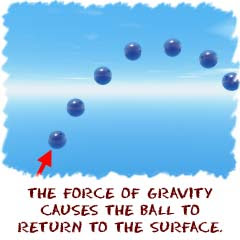Gravity | Circuit Monkeys Blog
 |
| Source |
Without gravity, we would fly off the spinning Earth and into space. Gravity is a force of attraction that acts between any two objects. The objects can be as large as galaxies or as small as subatomic particles. The strengths of the gravity between two objects depends on their masses an the distance between them. Objects with large masses exerts a strong force of gravity. Objects far apart attract each other weakly.
Centre of gravity:
 |
| Source |
Every object consist of tiny particles of matter. Each of these particles has a small force of gravity acting upon it. Together, the forces acts like a single force pulling downwards at just one point, called centre of gravity. An object will balance when it is supported in line with its centre of gravity. Balancing is easiest if the object has a low centre of gravity.
Weight:
 |
| Source |
Earth's Gravity:
Gravity always acts towards the centre of the Earth, defining the 'downwards' direction at every point on the surface of the planet. Gravity pulls a juggling ball towards the ground, slowing as it rises, and speeding up as it falls. The ball also pulls on the earths, but the Earth is so massive the the ball's gravity has no noticeable effect.
**Moons gravity: The moon is smaller and has mass less than the Earth, so the force of gravity is weaker on the moon. A hammer on the moon weighs one-sixth of its weight on the Earth. It takes 1.1 seconds for a hammer to fall 1 m (3.3 ft) on the Moon, but only 0.44 seconds on the Earth.
 |
| Source |
Gravity in Space:
Gravity is a universal force, because it acts between any two objects, wherever they are in the universe. The force that keeps our feet firmly on the ground is the same one that holds huge clusters of stars together as galaxies.
Galaxies: A typical galaxy is about 100000 light years across. The stars are so massive that gravity can still act over this huge distance, preventing the stars from drifting of into space.
Planetary orbits:
Gravity holds the planets of the solar system in orbit around the Sun. Venus and the Earth have similar masses, but because Venus is closer to the Sun than the Earth, the force of gravity keeping it in orbit is greater.
General relativity:
In 1915, German-born physicist Albert Einstein Published his Theory of General Relativity. This theory sees gravity not as a force, but as a curvature of space caused by bodies of matter. In 1919, the theory was used successfully to explain why Mercury's orbit gradually varies over time.
Tides:
 |
| Source |
Twice each day, the waters of the ocean ride a little then fall back. This Movement is called tide, and it is caused by the pull of the Moon's gravity. The sun also influences tides, When the Earth, Sun, and Moon are in line, their combined gravity produces tides that are higher than normal, called spring tides.
*Data and Images are collected mainly from internet, as well as various books. Any correction in data is welcome.
Fin!



Comments
Post a Comment